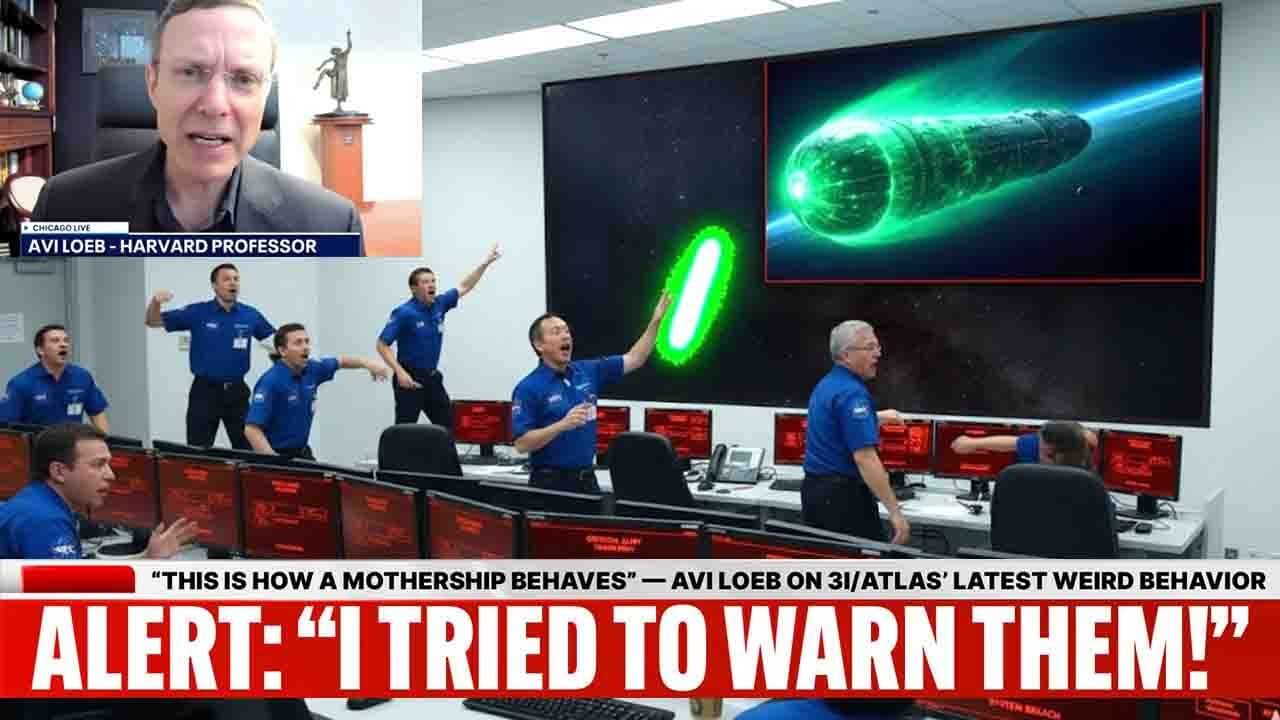In July 2025, astronomers discovered 3I/ATLAS, an interstellar object passing through our solar system. Unlike its predecessors, ʻOumuamua and Borisov, 3I/ATLAS exhibits peculiar characteristics that have sparked debates among scientists. Harvard astrophysicist Avi Loeb has raised the possibility that this object might be an alien spacecraft, citing anomalies in its trajectory, strange chemical emissions, and unprecedented sunward jets. Its unusual path and mysterious glow have left researchers questioning whether this is a natural interstellar visitor or something far more extraordinary.
The Discovery of 3I/ATLAS
3I/ATLAS was first detected by the Hubble Space Telescope on July 1, 2025. Measuring roughly 20 kilometres across, it moves at extraordinary speeds, indicating an origin beyond our solar system. Its trajectory brought it near Mars, immediately capturing global attention.
The object’s path is aligned closely with the ecliptic plane, an unusual orientation for interstellar objects. This near-perfect alignment has led some scientists to consider whether it might be deliberately guided rather than random.
Unlike other interstellar visitors, 3I/ATLAS does not display a typical cometary tail. Instead, it emits a faint glow ahead of its path, a puzzling feature that challenges conventional models of comet behaviour.
Avi Loeb’s Hypothesis
Avi Loeb, a Harvard astrophysicist, has suggested that 3I/ATLAS could be an alien spacecraft. He highlights its anomalous trajectory, lack of conventional tail, and unusual glow as potential signs of artificial origin.
This Is How A Mothership Behaves” — Avi Loeb On 3I/ATLAS’ Latest Weird Behaviour
The object’s alignment along the ecliptic plane is statistically improbable for a natural object, leading Loeb to propose that it may be intentionally navigated.
Loeb also notes its size and speed, both of which exceed previous interstellar visitors, adding weight to the theory that 3I/ATLAS could be engineered rather than natural.
Chemical Composition Anomalies
Spectroscopic studies reveal that 3I/ATLAS emits rare compounds, including nickel tetracarbonyl, a chemical typically produced through industrial processes. This unusual composition raises further questions about its origin.
The gas plume contains a high concentration of nickel while lacking the iron typically found in comets. This deviation from natural chemical patterns intensifies the mystery surrounding the object.
These anomalies have prompted scientists to reassess its classification, as traditional explanations struggle to account for the observed elements and ratios.
The Sunward Jet Phenomenon
3I/ATLAS exhibits a sunward jet, expelling material toward the Sun rather than away from it. This “anti-tail” is unprecedented and cannot be explained by known cometary physics.
Such movement suggests the possibility of artificial propulsion, as the object appears to manoeuvre in ways that defy natural expectations.
The sunward jet adds to the growing list of peculiarities, emphasizing the object’s departure from conventional celestial behaviour and raising the question of deliberate design.
The Oberth Manoeuvre Hypothesis
Loeb has proposed that 3I/ATLAS might perform an Oberth manoeuvre, a technique in which a spacecraft gains velocity by using a celestial body’s gravity. Its trajectory and timing suggest this could be feasible.
If capable, the object could navigate strategically within the solar system to collect data or reposition itself covertly.
The perihelion, its closest approach to the Sun, coincides with a period of obscured visibility, providing an ideal window for potential manoeuvres and reinforcing the theory of advanced capabilities.
The Wow! Signal Connection
3I/ATLAS’ approach coincides with the direction of the 1977 “Wow! Signal,” a powerful and unexplained radio emission. This alignment has led some to speculate about a possible connection between the two events.
Researchers wonder if the object could be linked to past signals or communications, though current evidence is circumstantial.
Regardless, the coincidence adds a layer of intrigue, sparking debate over the potential for deliberate extraterrestrial signalling in our solar system.
Scientific Community’s Response
Reactions among scientists remain divided. While some support Loeb’s hypothesis of an artificial origin, others argue that 3I/ATLAS’ features could be explained by natural processes.
Debates underscore the challenges of studying fast-moving interstellar objects with limited observational windows.
Despite disagreement, 3I/ATLAS has renewed interest in interstellar exploration and the search for extraterrestrial intelligence, offering a rare opportunity to study phenomena beyond conventional expectations.
Potential Implications for Humanity
If confirmed as an alien spacecraft, 3I/ATLAS would fundamentally alter humanity’s understanding of life and our place in the cosmos.
Its approach raises urgent questions about the intentions of its creators and whether it is merely observing or preparing for further activity.
The discovery would necessitate carefully developed protocols for contact, balancing curiosity, caution, and the unprecedented risks of interacting with an advanced extraterrestrial presence.
Future Observations and Missions
As 3I/ATLAS continues its journey, astronomers plan intensified observations. Upcoming missions could allow closer study using advanced imaging, spectroscopy, and potentially sample-return attempts.
These efforts will help determine whether its anomalous behaviour results from natural processes or artificial design, capturing transient phenomena crucial to understanding its nature.
International collaboration is essential, enabling coordinated observations and data sharing among space agencies and researchers worldwide to ensure comprehensive study.
Conclusion
3I/ATLAS challenges conventional understanding with its trajectory, chemical composition, sunward jets, and potential artificial features. Whether comet, spacecraft, or something entirely unexpected, it forces scientists to reconsider established models of interstellar objects.
Its combination of anomalies and possible links to historical signals ensures the debate will continue, with humanity standing on the threshold of a discovery that could redefine our place in the universe.

